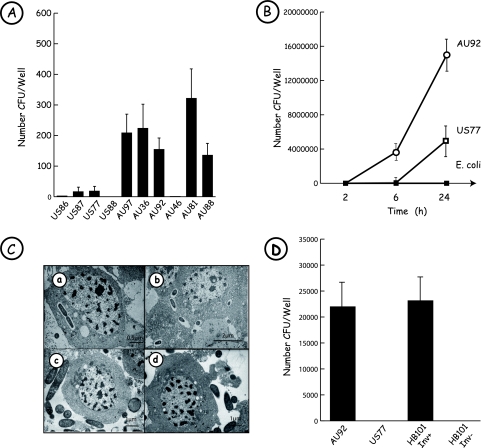FIG. 1.
Photorhabdus asymbiotica is a facultative intracellular bacterium. (A) Comparison of Photorhabdus clinical strain uptake by human THP-1 cells. Infection experiments were performed at an MOI of 25:1 with PMA-differentiated THP-1 cells and with the different bacterial strains listed in Table 1. After 2 h of gentamicin treatment (100 μg/ml), macrophage-like cells were lysed, intracellular bacteria were recovered, and the number of CFU/well was determined. All Australian clinical isolates were engulfed by macrophages, except for strain AU46. The American isolates were weakly phagocytosed. Results are representative of three independent experiments. (B) Survival and growth of P. asymbiotica AU92 and US77 in human THP-1 cells. THP-1 cells were challenged with P. asymbiotica strains at an MOI of 25:1 and treated for 2 h with 100 μg/ml gentamicin. At different times postinfection, cells were lysed and bacteria plated. The American (open squares) and Australian (circles) clinical isolates studied were able to survive in THP-1 cells, in contrast to the nonpathogenic E. coli XL1-Blue strain (filled squares), which was eliminated by macrophage-like cells. Results are representative of three independent experiments. (C) Bacteria of clinical strains are present inside insect hemocytes. Hemocytes of M. unipuncta were incubated with P. asymbiotica AU92 (a and b), P. luminescens TT01 (c), or P. asymbiotica US77 (d). TEM observations show that the human clinical isolate P. asymbiotica AU92 is phagocytosed by hemocytes. In contrast, the strictly entomopathogenic organism P. luminescens, as well as P. asymbiotica US77, present an extracellular location. (D) Invasion of epithelial cells by P. asymbiotica. HeLa cells were infected for 1 h with the P. asymbiotica strains AU92 and US77 and with E. coli HB101 Inv+ (carrying the inv gene of Yersinia) and E. coli HB101 Inv− as negative controls (MOI, 25:1). After 2 h of treatment with 100 μg/ml gentamicin, cells were lysed and intracellular bacteria plated. The Australian strain of P. asymbiotica was able to invade HeLa cells, with an intracellular uptake rate similar to that of E. coli HB101 harboring the Yersinia inv gene. Results are representative of three independent experiments.

